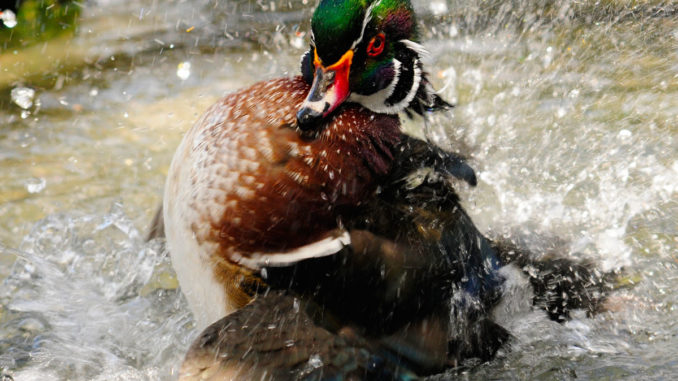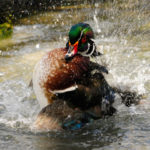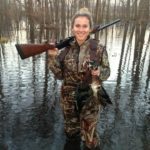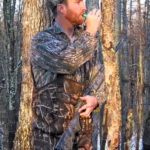
A small decoy spread, good camo and crafty calling can make a small body of water into a duck factory.
Ethan Amerson of Timmonsville trudged through knee-deep water, protected by a pair of waders but still feeling enough of the chill to keep him fully in touch with his surroundings. Guided by the faint light of the early morning sky through flooded cypress knees that gave way to a long, narrow clearing of thigh-deep water, Amerson pitched a pair of mallard decoys out and made his way to the spot he wanted to stand, watching his brother, Chuck, toss out two wood duck decoys to his right and friend Scott Rollins of Bishopville putting two teal decoys in the drink to his left.
The three hunters are hiding in plain sight, fully camouflaged, looking like standing timber in the flooded swamps of Lee County’s Lynches River. The fog of their hot breath in the cold air is the only thing distinguishing them from the trees, and the three men spend the next 15 minutes in silence while the whistles of distant wood ducks and the occasional slap of a beaver’s tail against the water’s surface keeps their senses sharp.
As the sun creeps into the swamp, Rollins spots a small flock of mallards heading from their nesting area to the open water of the Lynches River and calls to them, turning them into their decoy spread. Still too early to shoot, the men watch the greenheads’ silhouettes disappear into the background of trees as they pitch into the spread and splash down gracefully within mere feet of the hunters.
With the mallards churning up the water, the men stand silent again as a few moments pass, and as legal shooting time arrives, so does a bigger group of mallards, preparing to light in the spread of dekes and live birds. Silence gives way to the boom of shotguns, and as the earlier ducks take flight off the water, some of the incoming birds fall, crashing to the surface. More shotgun blasts join feathers in the air, sending some of the escaping birds back to the water.
The men celebrate in muted tones, and as Rollins prepares to retrieve the downed birds, Chuck Amerson works a wood duck call, stopping Rollins, who looks skyward and shucks new shells into his 12-gauge. The earlier scene repeats itself, but this time with woodies, and within minutes, the three men have their limits of mallards and wood ducks, and they begin scanning the sky earnestly for the quick teal, who, while less numerous in this area, show up often enough to keep the men silent and still for a good hour longer, watching as more flocks of mallards and wood ducks pass over, some far out of range, and some almost hitting the men as they patiently wait for the teal to arrive.
The teal never show up, and the Amerson brothers help Rollins collect their harvest and make their way out of the swamp. This is small-water duck hunting, and aside from limiting out on two species as quickly as it took them to set up, these three hunters, as well as countless others across the Palmetto State, have a leg up on their big-water brethren.
“After cleaning these ducks and washing up, we’re all heading to work,” Rollins said. “That’s one big advantage of hunting this way. Today is Wednesday, and most big-water duck hunters are heading to work today and yearning for Saturday so they can haul a boat to Santee or Winyah Bay, set out dozens of decoys, then compete with all the other hunters calling and doing the same thing they are. But for us, this is just a regular day. The only difference is we got a little less sleep.”
“And we’ll gladly trade sleep to be here,” Chuck Amerson said as he glanced around the flooded swamp.
Ethan Amerson said this type hunting allows for a minimalist approach, which appeals to him.
“We don’t have to deal with blinds, boats, getting gas, keeping outboards running. We each bring two decoys apiece, duck calls and our guns and shells. That’s all we need, and I don’t remember the last time we didn’t all limit out on whatever species showed up.”
“Now those big-water hunters do have access to more species of birds than we do, but hunting small waters closer to the coast would give hunters like us chances at all those same birds,” Rollins said, admitting that just showing up isn’t enough to guarantee success. Setting up properly is important. Other than that, he believes the three most important parts of duck hunting are camouflage, calling and decoys.
“We know where the ducks nest, and we know where they head at first light,” Ethan Amerson said. “That’s why we set up where we do, but the ducks don’t always take the most direct flight, so that’s where the three essentials come in to play.
“I know guys that have their share of success without calling at all, but calling increases the amount of ducks that will fly into range, and it can turn a slow day into a day full of action,” he said.
“When you turn a group of ducks by calling, they’re looking for what’s calling them. If they don’t see decoys, they are much less likely to land where you want them, but there is no need to go overboard by slinging out dozens of dekes. Just a handful is plenty,” said Amerson, who doesn’t want his decoys packed in a tight group — nervous ducks group up tightly, he said, so decoys should look relaxed and inviting.
Nothing, Rollins said, is more important than camouflage.
“Even without calling or decoying, at least a few ducks will fly through here at some point. If you aren’t fully camouflaged,” he said, “ducks will steer clear.”
Rollins stresses using a facemask, face paint or his preferred method: using mud on his face.
“Some folks overlook camouflaging their hands, too, but that is enough to alert ducks, so camo or dark-colored gloves are a must,” he said.
The Amersons and Rollins use a variety of shot sizes and a host of guns.
“This is close-quarters shooting, so we aren’t particular about what size shot we use,” said Rollins. “It’s a fun way to try smaller gauges, and hunting this way also gives us opportunities to try everything from passing shots to head-on shots. Ducks landing, ducks taking off, and takes buzzing by at light speed all happen in here, so it’s fun and challenging.”
Not everyone has access to swamps like the one Rollins and the Amersons hunt, but they can still have success shooting ducks. Farm ponds, small streams, drainage ditches and even oak groves with the smallest of water holes can draw ducks. And while the numbers and species of ducks may change, the rules remain the same for finding big success in small waters.







Be the first to comment